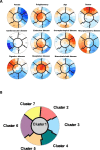Identifying patterns of multimorbidity, polypharmacy and frailty in the elderly: a clustering analysis of baseline data from a French, randomised, controlled trial in primary care
- PMID: 40578876
- PMCID: PMC12207111
- DOI: 10.1136/bmjopen-2023-083584
Identifying patterns of multimorbidity, polypharmacy and frailty in the elderly: a clustering analysis of baseline data from a French, randomised, controlled trial in primary care
Abstract
Objectives: To identify distinct profiles among elderly patients in primary care so that general practitioners (GPs) can develop more targeted care strategies.
Design: A cross-sectional analysis of baseline data from the French nationwide 'Elderly Appropriate Treatment in Primary Care' trial.
Setting: Primary care in France: 277 GPs included patients.
Participants: The study participants were aged 75 or over, living at home, and taking five or more prescription medications. Of the 2724 patients included, 2651 were analysed.
Primary and secondary outcome measures: To identify specific patterns of multimorbidity, polypharmacy and frailty, we applied an unsupervised clustering analysis with self-organising maps.
Results: Seven clusters were identified: cluster 1 (16% of the patients) comprised frail men and women with cardiovascular, respiratory, musculoskeletal and endocrine diseases and marked polypharmacy; cluster 2 (9.3%, mainly men) comprised frail patients with cancer and cardiovascular or urogenital/renal diseases; cluster 3 (15.5%, mainly men) comprised not-very-frail patients with cardiovascular and urogenital/renal diseases; cluster 4 (18.1%) comprised not-very-frail men and women with cardiovascular diseases; cluster 5 (13.5%, mainly women) comprised mainly lonely, very frail patients with hypertension and endocrine, musculoskeletal and neuropsychiatric disorders; cluster 6 (19.1%, mainly women) comprised frail, socially isolated patients with digestive, musculoskeletal and neuropsychiatric diseases; lastly, cluster 7 (8.6%, mainly women) comprised frail, socially isolated patients with hypertension, cancer, or musculoskeletal, psychological and digestive disorders.
Conclusion: Our phenotypic classification of elderly patients might facilitate efforts to align healthcare services with the care needs that are encountered by GPs in their everyday practice. TRIAL REGESTRATION NUMBER: (NCT03298386).
Keywords: Aged; Chronic Disease; Frailty; Polypharmacy; Primary Health Care.
© Author(s) (or their employer(s)) 2025. Re-use permitted under CC BY-NC. No commercial re-use. See rights and permissions. Published by BMJ Group.
Conflict of interest statement
Competing interests: None declared.
Figures




References
Publication types
MeSH terms
Associated data
LinkOut - more resources
Full Text Sources
Medical
